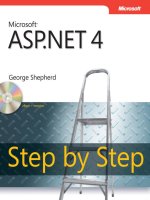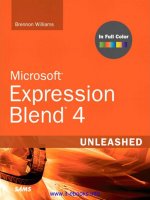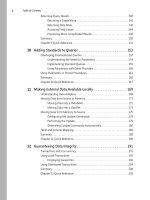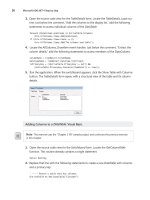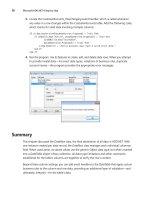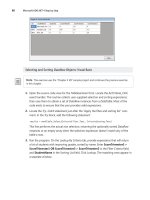Microsoft expression blend 4 step by step - Elena Kosinska chris leeds pdf
Bạn đang xem bản rút gọn của tài liệu. Xem và tải ngay bản đầy đủ của tài liệu tại đây (29.48 MB, 413 trang )
Published with the authorization of Microsoft Corporation by:
O’Reilly Media, Inc.
1005 Gravenstein Highway North
Sebastopol, CA 95472
Copyright © 2011 by Elena Kosinska and MediaCarbon, Inc.
All rights reserved. No part of the contents of this book may be reproduced or transmitted in any form or by any means
without the written permission of the publisher.
Unless otherwise noted, the example companies, organizations, products, domain names, email addresses, logos, people,
places, and events depicted herein are ctitious. No association with any real company, organization, product, domain name,
email address, logo, person, place, or event is intended or should be inferred.
Microsoft Press titles may be purchased for educational, business, or sales promotional use. Online editions are also available
for most titles (). For more information, contact our corporate/institutional sales department:
(800) 998-9938 or
Complying with all applicable copyright laws is the responsibility of the user. Without limiting the rights under copyright,
no part of this document may be reproduced, stored in or introduced into a retrieval system, or transmitted in any form or
by any means (electronic, mechanical, photocopying, recording, or otherwise), or for any purpose, without express written
permission of O’Reilly Media, Inc.
1 2 3 4 5 6 7 8 9 QG 6 5 4 3 2 1
Microsoft, Microsoft Press, the Microsoft Press brand, Access, ASP.NET, DirectX, DreamSpark, Deep Zoom, Excel,
Expression Blend, Expression Design, Expression Encoder, Expression Studio, Expression Web, FrontPage, .NET, Ofce,
Silverlight, SQL Server, Visual Basic, Visual C++, Visual C#, Visual Studio, Visual Web Developer, Web Platform,
WebsiteSpark, and Windows are either registered trademarks or trademarks of Microsoft Corporation in the United States
and/or other countries.
This book expresses the author’s views and opinions. The information contained in this book is provided without any express,
statutory, or implied warranties. Neither the author, O’Reilly Media, Inc., Microsoft Corporation, nor their respective resellers,
or distributors will be held liable for any damages caused or alleged to be caused either directly or indirectly by this book.
Acquisitions and Developmental Editor: Russell Jones
Production Editor: Adam Zaremba
Editorial Production: Online Training Solutions, Inc.
Technical Reviewer: Kathleen Anderson
Illustrator: Robert Romano
Indexer: Ginny Munroe
Cover: Karen Montgomery
978-0-735-63901-0
v
Contents at a Glance
1 Welcome to the Silverlight and WPF World 1
2 Exploring the Expression Blend 4 IDE 13
3 Designing an Interface 49
4 XAML and C# 91
5 Animations and Transformations 127
6 Adding Interactivity 159
7 Creating Design Assets 185
8 Resources 223
9 Skinning Controls 247
10 Working with Data 289
11 Using SketchFlow 321
12 Designer/Developer Collaboration 363
vii
Table of Contents
Acknowledgements xiii
Introduction xv
1 Welcome to the Silverlight and WPF World 1
Introducing Silverlight and WPF 1
The Designer/Developer Workow 3
Expression Studio: The Designer’s World 3
Visual Studio: The Developer’s World 9
Key Points 11
2 Exploring the Expression Blend 4 IDE 13
Downloading and Installing Expression Blend 4 and Supporting Tools 14
Downloading Expression Blend 4, Trial Version 14
Downloading the NET Framework 4 Runtime 15
Downloading Silverlight 4 16
Installing the NET Framework 4 Runtime 17
Installing Expression Studio 4 Ultimate with
Expression Blend 4 18
Installing Silverlight 4 20
Opening and Testing Your First Silverlight Project 21
Exploring the User Interface 24
Exploring the Panels 25
Understanding the Tools Panel, Authoring Views, and Workspace
Congurations 32
Customizing the User Interface 38
Changing the Color Scheme, Artboard Background, and
Other Options 38
Controlling Expression Blend’s Panels 43
Switching Between Workspaces 46
Key Points 48
viii Table of Contents
3 Designing an Interface 49
Visual Elements 49
Creating a New Project 51
Using Basic Shapes 53
Drawing Paths 58
Using Custom Shapes 64
Using Controls 69
Using Layout Panels 71
Arranging Objects 72
Using Images and Video 81
Using Images 81
Using Video 86
Key Points 90
4 XAML and C# 91
XAML—What Is It? 91
Using the XAML Editor in Expression Blend 94
XAML Objects 98
XAML Properties 101
The XAML Root Element 107
Naming Objects 108
Introducing C# for Designers 110
Objects, Classes, and Other Terminology 111
XAML Code and Code-Behind Files 113
Creating Objects in C# 115
Using Event Handlers 120
Key Points 126
Table of Contents ix
5 Animations and Transformations 127
Transformation 127
Resizing (Not a Transformation) 128
Transformations 129
Animation 139
Creating a Storyboard and Adding an Animation 140
Controlling the Storyboard 145
Changing the Storyboard 147
Modifying an Animation and Adding New Keyframes 148
Easing an Animation 151
Using Storyboards 153
Key Points 157
6 Adding Interactivity 159
Behaviors 159
The Basics of Behaviors 160
Using Default Behaviors 162
Using the ToggleButton Control to Change Properties 175
Switching Visual States 179
Key Points 184
7 Creating Design Assets 185
Using Expression Design 185
Exploring the Expression Design Toolbox 187
The Properties Panel 188
The Layers Panel 193
The Action Bar 197
Preparing Assets 197
Exporting to XAML from Expression Design 211
Importing Design Assets from Adobe Applications 214
Key Points 222
What do you think of this book? We want to hear from you!
M crosoft s nterested n hear ng your feedback so we can cont nua y mprove our
books and earn ng resources for you To part c pate n a br ef on ne survey, p ease v s t:
microsoftcom/learning/booksurvey
x Table of Contents
8 Resources 223
Color Resources 223
Brush Resources 228
Image Brush Resources 232
Other Resources 234
Modifying Resources 238
Working with External Resource Dictionaries 243
Key Points 246
9 Skinning Controls 247
Structure of Common Silverlight Controls 248
The Button Control 248
The CheckBox Control 249
The Slider Control 251
The TextBox Control 252
The ScrollBar Control 253
The ListBox Control 254
Creating and Using Styles 254
Templates 265
Creating Beautiful Custom Buttons 265
Creating Silverlight Themes 274
Drawing Controls 275
Skinning a Control for a Theme 277
Optimizing an Output Theme 285
Template Binding 285
Key Points 287
10 Working with Data 289
Sample Data 290
Creating and Modifying Sample Data 291
Changing a Data Template 298
Data Binding 304
Element Property Binding 310
Using a Master/Details Scenario to Display Data 313
Key Points 319
Table of Contents xi
11 Using SketchFlow 321
Sketching 321
Creating and Running a SketchFlow Project 323
Creating an Application Flow 326
Navigation and Component Screens 329
Adding Controls and Data 333
Adding Controls to Your Prototype 333
Using Sample Data 335
Sketch Illustrations 341
Adding Interactivity to a SketchFlow Project 342
Adding Additional Navigation 343
Using States and Behaviors 347
Changing SketchFlow Player Settings 352
Packaging a Prototype 353
Getting Feedback 355
Generating Documentation 359
Key Points 361
12 Designer/Developer Collaboration 363
A Typical Design Workow 363
The Designer’s Role 385
The Developer’s Role 386
Key Points 386
Index 387
Author Bios 399
What do you think of this book? We want to hear from you!
M crosoft s nterested n hear ng your feedback so we can cont nua y mprove our
books and earn ng resources for you To part c pate n a br ef on ne survey, p ease v s t:
microsoftcom/learning/booksurvey
xv
Introduction
Microsoft Expression Blend 4 is Microsoft’s newest interactive design tool It’s intended for
designers and developers who need to create user interfaces for rich Internet, desktop, and
mobile applications—and it offers tools that support the design of such applications, from
conception to completion
Expression Blend 4 is part of Microsoft Expression Studio 4 Ultimate, a suite of design tools
that includes the impressive SketchFlow feature, which helps designers rapidly experiment
with dynamic user experiences and create compelling functional prototypes
Expression Blend provides powerful tools for integrating sample data into your application
If you’re just beginning an application design and have no existing sample data to ll it with,
Expression Blend provides sample data sources that you can use to populate the application
with temporary (but realistic) data If you do have sample data, Expression Blend lets you use
that In both cases, you’ll be able to view the sample data while you design the user interface—
even before the application gets connected to the nal “live” data source
With Expression Blend, you can even integrate graphics created in other design tools, such as
Microsoft Expression Design, Adobe Illustrator, and Adobe Photoshop The easiest source for
integrating external graphic assets is Expression Design The Expression Design + Expression
Blend combination provides simple integration paths, because both applications are in the
Expression Studio family But you aren’t limited to that combination There are powerful im-
porting tools that integrate assets from Adobe products as well With Expression Blend, the
choice of graphic design tools is up to you
Expression Blend also makes it easy to enable interactivity without writing code Behaviors,
which are powerful interactivity building blocks, were developed expressly so that designers
could add interactivity to applications without writing code To use behaviors, you simply drag
them onto objects in Expression Blend, set their properties, and enjoy the resulting interactivity
The most common task for user interface designers—skinning controls—involves under-
standing the structure of common controls and creating reusable styles for applications
Powerful Expression Blend style/template editing capabilities help designers to carefully
modify the look and feel of default Microsoft Silverlight or Windows Presentation Foundation
(WPF) controls while retaining their functionality
Expression Blend 4 also makes design workow easier than ever before Designers and
developers can work seamlessly, sharing projects, code, and designs for better productivity
and higher quality results
xvi Introduction
HowtoAccessYourOnlineEditionHostedbySafari
The voucher bound in to the back of this book gives you access to an online edition of the
book (You can also download the online edition of the book to your own computer; see the
next section)
To access your online edition, do the following:
1. Locate your voucher inside the back cover, and scratch off the metallic foil to reveal
your access code
2. Go to http://microsoftpressoreillycom/safarienabled
3. Enter your 24-character access code in the Coupon Code eld under Step 1
(Please note that the access code in this image is for illustration purposes only)
4. Click the CONFIRM COUPON button
A message will appear to let you know that the code was entered correctly If the code
was not entered correctly, you will be prompted to re-enter the code
5. In this step, you’ll be asked whether you’re a new or existing user of Safari Books
Online Proceed either with Step 5A or Step 5B
5A. If you already have a Safari account, click the EXISTING USER – SIGN IN button
under Step 2
SystemRequirements
To perform the exercises in this book, your computer should meet the following requirements:
■
Windows XP with Service Pack 3, Windows Vista, Windows 7, or Windows Server 2008
operating system
■
Computer with 1 GHz or faster processor
■
1 GB of RAM or more
■
2 GB or more of available hard-disk space
■
Microsoft NET Framework 4
■
Silverlight 4
■
Support for Microsoft DirectX 90 graphics with Windows Vista Display Driver Model
(WDDM) Driver, 128 MB of graphics RAM or more, Pixel Shader 30 in hardware, 32-bits
per pixel
■
1024 × 768 or higher resolution monitor with 24-bit color
■
Internet functionality, which requires Internet access (additional fees may apply)
Important
Actua requ rements and product funct ona ty may vary based on your system
congurat on and operat ng system
WhoShouldReadThisBook?
This book is intended for existing or new User Interface/User Experience designers, developers,
and design integrators, as well as those who need some basic knowledge of the tools and
capabilities used by designers Although the book is expressly intended to provide information
and step by step examples for new designers, experienced practitioners can use this book as
well, to quickly gain familiarity with the Expression Blend 4 user interface and features The
book will also serve Adobe Flash designers who want to expand their professional repertoire
into the Silverlight and WPF arena
Assumptions
The authors expect that you have at least a minimal understanding of the computer you will
be using as well as familiarity performing le operations with your chosen operating system
You do not need deep experience in design or development, although a general familiarity
with common computer graphics tools is helpful
xx Introduction
What’sNewinExpressionBlend4
Silverlight4andWPF4projects Expression Blend provides powerful features for design-
ing and developing applications based on Silverlight 4 and Windows Presentation
Foundation 4 technologies
Shapes Expression Blend 4 now includes presets to help designers easily create arcs,
arrows, callouts, and polygons, in both sketch and other styles You can nd this
feature in the Assets panel within the new Shapes category
SketchFlowimprovements SketchFlow Player now enables panning, scrolling, and screen
resizing of SketchFlow prototype applications The SketchFlow map is available as an
overlay on selected screens SketchFlow can generate documentation as Microsoft
Word les, and can even include feedback from your team and customers
LayoutStatesfortheListBoxItem Designers can animate the process of items being
added and/or removed from a ListBox in Silverlight 4 projects The new states group
includes BeforeLoaded, AfterLoaded, and Loaded states
EasingfunctionsandTransitionEffects Easing functions for animations and Visual State
changes are now available for WPF 4 projects Transition Effects such as Fade, Pixelate,
Slide In, and many others are available through the States panel Designers can easily
combine visual effects
Newbehaviors Expression Blend 4 has a set of new behaviors, such as DataStateBehavior,
SetDataStoreValueAction, CallMethodAction, FluidMoveBehavior, and others, which
Microsoft added to help designers work with data
DataStore Designers can now store application variables in Data Store Variables can be
read and written to that storage so that they will be available for different parts of
the application
AdobePhotoshopimportimprovements Expression Blend now has a faster and
improved Photoshop import dialog box that enables designers to easily choose layers
to be imported and merge effects for Photoshop les
DevelopmentusingtheMVVMPattern Expression Blend 4 supports a new type of
project: Silverlight Databound Application This project type builds on the Model
View ViewModel (MVVM) design pattern, which uses data and command bindings
to support a loose coupling between a View (a user interface) and a ViewModel
(code that coordinates the state of a View with an underlying Model)
Introduction xxi
DevelopmentforWindowsPhonePlatform With Expression Blend for Windows Phone,
available when you install the Windows Phone Developer Tools and Expression Blend 4
Service Pack 1, you can quickly and easily design Silverlight applications for Windows
Phone by using the design tools in Expression Blend As you create your Windows
Phone applications, you can easily test them on either the Windows Phone emulator,
included as part of the Windows Phone Developer Tools, or in a Windows Phone device
attached to your computer
AcquiringExpressionBlend4
Expression Blend 4 is available as part of Expression Studio 4 Ultimate, which is an integrated
group of applications that includes:
■
ExpressionBlend4andSketchFlow Using industry-proven technologies and
languages such as Silverlight, WPF, XAML, Microsoft Visual C#, and Microsoft Visual
Basic, Expression Blend enables you to deliver applications that are stable, scalable,
accessible, reliable, and highly secure, while maintaining optimum performance
SketchFlow, a feature of Expression Blend 4, revolutionizes how quickly and efciently
designers can demonstrate their vision for an application SketchFlow projects provide
an informal way to quickly explore, iterate, and prototype user interface scenarios, and
enable designers to evolve their concepts from a series of rough ideas into an interactive
and functional prototype that can be made as realistic as a client or project demands
■
ExpressionWeb4andSuperPreview Expression Web is a professional design tool
used to create engaging, web-connected multimedia experiences SuperPreview speeds
browser compatibility testing by not only showing a high-delity rendering of how
pages will look on various browsers, but also by identifying an element’s tag, size and
position, applied styles, and location in a convenient Document Object Model (DOM)
tree, so you can quickly remedy any cross-browser issues you uncover
■
ExpressionDesign4 Microsoft Expression Design 4 is the perfect companion to
Expression Blend or Expression Web Take advantage of existing artwork, or use intuitive
vector drawing tools to quickly build sophisticated vector and image assets Seamlessly
transfer them to your Expression Blend or Expression Web projects knowing that their
delity and effects will be maintained throughout the entire designer-developer workow
■
ExpressionEncoder4Professional Microsoft Expression Encoder simplies publish-
ing video to Silverlight With Expression Encoder, you can encode a wide array of video
le formats, stream live from webcams and camcorders, or even record screen videos
on your computer You can also make simple edits to video les as well as add overlays
and advertising Users can choose encoding settings, choose a video player interface
from a range of player templates, and publish rich media experiences with Silverlight
directly to the web The professional version of Expression Encoder contains more import
and export codecs and unlimited screen recording duration
xxii Introduction
Expression Studio 4 Ultimate is also available as an upgrade—and the upgrade isn’t limited to
users of just Expression Blend 3 It is available to owners of any previous Microsoft Expression
product as well as any version of Adobe Creative Suite or Microsoft Visual Studio 2005 or later
Beyond that, you can get Expression Studio 4 Ultimate as part of the Microsoft Partner pro-
gram, at and through the WebsiteSpark program at
Finally, if you’re a student, you can get Expression Studio 4 Ultimate and a huge collection of
other Microsoft development software through DreamSpark, at downloads.channel8.msdn.com/
Default.aspx Microsoft DreamSpark lets students download Microsoft developer and design
tools at no charge, making it easier for them to learn the skills they need to excel both during
school and after graduation
SampleProjects
Most of the chapters in this book include exercises that let you interactively try out new
material learned in the main text All the sample projects are available for download from the
book’s page on the web site for Microsoft’s publishing partner, O’Reilly Media:
/>Click the Companion Contentlink on that page under the book cover image When a list of
les appears, locate and download the SampleProjectszip le
Installing the Sample Projects
Unzip the SampleProjectszip le that you downloaded from the book’s website to a location
on your hard drive To simplify locating and using the sample les, unzip them to your desktop
What’s in the Sample Projects?
This book’s sample projects contain Silverlight projects, videos, images, Expression Design,
and other graphic assets that are required to complete the chapter exercises that you will
encounter in the book
Introduction xxiii
OrganizationofThisBook
■
Chapter 1: Welcome to the Silverlight and WPF World
❑
Identify the basics of Silverlight and WPF technologies
❑
Differentiate between designer and developer roles
❑
Recognize products in Expression Studio 4
❑
Understand how Visual Studio can t into your design process
■
Chapter 2: Exploring the Expression Blend 4 IDE
❑
Download and install Expression Blend 4
❑
Open and run your rst Silverlight project
❑
Use and customize the Expression Blend 4 user interface
■
Chapter 3: Designing an Interface
❑
Create a new project
❑
Place visual elements and common controls in your project
❑
Use layout panels as containers for arranging objects
❑
Use image and video elements
■
Chapter 4: XAML and C#
❑
Understand what Extensible Application Markup Language (XAML) is
❑
List basic XAML objects and properties
❑
Use the XAML editor and IntelliSense in Expression Blend
❑
Understand the basics of C#
❑
Explain the relationship of code-behind les to XAML les
❑
Create objects in C#
❑
Change properties of existing objects by using C# code
❑
Respond to events with event handlers
■
Chapter 5: Animations and Transformations
❑
Resize user interface (UI) elements
❑
Scale, rotate, skew, and translate your objects
❑
Change the center point of an object
❑
Flip objects
❑
Simulate three-dimensional space via projection
xxiv Introduction
❑
Add storyboards
❑
Use timelines and keyframes
❑
Add animations and change object properties over time
❑
Modify storyboards
❑
Apply behaviors and run storyboards in response to events
■
Chapter 6: Adding Interactivity
❑
Use default Expression Blend behaviors
❑
Run storyboards based on behaviors
❑
Use behaviors to change properties of objects
❑
Use the ToggleButton control
❑
Modify the properties of behaviors
❑
Create visual states and switch between them
■
Chapter 7: Creating Design Assets
❑
Use Expression Design and its tools and panels
❑
Create graphic assets in Expression Design
❑
Export Expression Design assets as XAML to integrate into Expression Blend
❑
Import objects from Photoshop and Illustrator
■
Chapter 8: Resources
❑
Create color resources and use them in Expression Blend applications
❑
Create and apply gradient and image brushes
❑
Convert property values to resource values and apply them to properties of the
same type
❑
Modify existing resources
❑
Organize resources by using dictionaries
■
Chapter 9: Skinning Controls
❑
Create and use styles for controls and visual elements
❑
Modify existing control templates and create custom templates for controls
❑
Use states to change the behavior of controls
❑
Create a theme for basic controls
❑
Use color, brush, and other types of resources
❑
Use implicit and key-based styles
Introduction xxv
❑
Optimize resources and styles
❑
Set template binding for object properties within custom templates
■
Chapter 10: Working with Data
❑
Generate sample data
❑
Use styles and templates on data display controls
❑
Work with sample data
❑
Bind object properties to data
❑
Change data templates
❑
Use element property binding
❑
Use Master/Details scenarios to display data
■
Chapter 11: Using SketchFlow
❑
Create and run a SketchFlow application
❑
Navigate between SketchFlow screens
❑
Create an application ow
❑
Add controls and use sample data for prototyping
❑
Make your SketchFlow projects interactive
❑
Understand the SketchFlow Player settings
❑
Package your application prototype
❑
Use the feedback functionality to collect new ideas and comments
❑
Generate documentation in Word format
■
Chapter 12: Designer/Developer Collaboration
❑
Identify key points in a typical design workow
❑
Differentiate between designer and developer tasks and roles within the
workow
❑
Identify mixed tasks
❑
Share projects between Expression Blend and Visual Studio
❑
Understand the benets of using source control
xxvi Introduction
ConventionsandFeaturesinThisBook
This book has been designed to lead you step by step through all the tasks you are most
likely to want to perform in Microsoft Expression Blend 4 If you start at the beginning and
work your way through all the exercises, you will gain enough prociency to be able to create
rich user interfaces for your applications Each topic is self-contained, but some of them are
united with the same theme If you need a fast way to nd the information to perform a pro-
cedure, the following features of this book will help you locate specic information:
■
Detailedtableofcontents Scan this listing of the topics and sidebars within each
chapter to quickly nd the information you want
■
Detailedindex Look up specic tasks and features and general concepts in the index,
which has been carefully crafted with the reader in mind
■
Companioncontent Install the practice les needed for the step-by-step exercises
through this book’s website See the “Sample Projects” section of this Introduction for
instructions on getting and installing the practice les
In addition, this book presents information using conventions designed to make the informa-
tion readable and easy to follow:
■
Most chapters include step-by-step exercises that you can follow to get guided expo-
sure and practice to completing tasks
■
Each exercise consists of a series of tasks, presented as numbered steps (1, 2, and so on)
listing each action you must take to complete the exercise
■
Boxed elements with labels such as “Note,” “Troubleshooting,” and so on provide addi-
tional information, directions for starting or ending the step by step exercises, or alter-
native methods for completing a step successfully
■
Text that you are supposed to type (apart from code blocks) appears in bold
■
A plus sign (+) between two key names means that you must press those keys at the
same time For example, “Press Alt+Tab” means that you hold down the Alt key while
you press the Tab key
■
Tool icons that you need to recognize to work with Expression Blend appear where
they are rst mentioned You should strive to memorize these icons and their locations
in the Blend user interface as you work through the exercises
Introduction xxvii
Errata&BookSupport
We’ve made every effort to ensure the accuracy of this book and its companion content If
you do nd an error, please report it on our Microsoft Press site at oreilly.com:
1.
Go to
2.
In the Search box, enter the book’s ISBN or title
3.
Select your book from the search results
4.
On your book’s catalog page, in the list of links under the cover image, click View/
Submit Errata
You’ll nd additional information and services for your book on its catalog page If you need
additional support, please send an email message to Microsoft Press Book Support at
Please note that product support for Microsoft software is not offered through these
addresses
The authors also maintain a support site for this book and Expression Blend in general Visit
WeWanttoHearfromYou
At Microsoft Press, your satisfaction is our top priority, and your feedback our most valuable
asset Please tell us what you think of this book at:
/>The survey is short, and we read every one of your comments and ideas Thanks in advance
for your input!
StayinTouch
Let’s keep the conversation going! We’re on Twitter: /> 1
Chapter 1
Welcome to the Silverlight
and WPF World
After completing this chapter, you will be able to:
■
Identify the basics of Silverlight and Windows Presentation
Foundation (WPF) technologies
■
Differentiate between designer and developer roles
■
Recognize products in Expression Studio 4
■
Understand how Visual Studio can t into your design process
New and continually evolving technologies have always been, and will always be, attractive
to cutting-edge people To touch and use them is almost like touching the future The most
fortunate among us get to design and develop something based on these technologies and
produce amazing new software Contemporary end users are bored with the static nature of
previous development norms and increasingly expect friendly, good-looking, and interactive
interfaces Design is a competitive advantage in many of the products we use today Software
with a beautiful interface is always more viable than similar software with an unattractive
interface Design can provide a substantial return on investment in software applications
Important
There are no exerc ses n th s chapter, so no accompany ng pract ce es
are requ red
IntroducingSilverlightandWPF
Windows Presentation Foundation (WPF) is a comprehensive user interface platform with
which developers and designers can create amazing, visually stunning Windows applications
With WPF, developers and designers can build rich desktop applications based on vector
graphics, and WPF maintains a clear separation between the user interface and the business
logic Basically, WPF is the graphics subsystem in the Microsoft NET Framework 30 and NET
Framework 4 Developers who have some programming experience in NET languages such
as Microsoft Visual C# and Microsoft Visual Basic NET can easily start working in this area
WPF uses a markup language known as Extensible Application Markup Language (XAML)
that’s based on Extensible Markup Language (XML) With XAML, designers and developers
alike are free to create user interfaces in a very exible way, which is the reason why NET
developers and designers all over the world have begun to move their work to this platform
Silverlight is a lightweight platform for building Rich Internet Applications (RIAs) RIAs usually
run inside the browser and can provide a rich experience similar to traditional desktop appli-
cations Silverlight doesn’t have all the features of WPF; it’s missing some features, such as the
ability to work in real three-dimensional space without third-party plug-ins Also, for security
reasons, it typically does not have access to local devices and other system components—
those that are not usually available through a browser Don’t think of that as a deciency,
though; Silverlight has other great advantages For example, designers can build mobile appli-
cations in Silverlight and run them on the new Windows Phone 7 series of devices Silverlight
applications can also run as connected or disconnected desktop applications All these plat-
forms have commonalities—but each has its own niche and needs as well
Fortunately, Silverlight has been around long enough that it has a large and comprehensive
standard of controls—and when those aren’t enough, both free and commercial kits are
available to satisfy the requirements of even the most hard-to-please developers Based
on the historical development progression of Silverlight, it appears that future versions will
likely have an even smaller downloadable runtime, and Microsoft will continue to reduce
the differences between Silverlight and the full WPF platform
TheDesigner/DeveloperWorkow
It’s no secret that creating a great user experience takes two types of people, each of whom
thinks differently: designers and developers Until recently, designers and developers didn’t
usually work closely together, and they used tools from totally different families But that’s
rapidly becoming a thing of the past The WPF and Silverlight platforms unify and simplify
the designer/developer workow Designers work on the front end—creating beautiful user
interfaces, adding interactivity, and creating all sorts of cutting-edge elements Developers
work on the back end—writing code that enables application functionality Both designers
and developers can use the same type of project, have a common point of tangency—XAML—
and work within one platform
ExpressionStudio:TheDesigner’sWorld
Designers need a design suite optimized for their role, one that lets them collaborate
effectively with developers, create high-quality interfaces, and add interactivity to WPF and
Silverlight applications To meet this need, Microsoft created Expression Studio—a profes-
sional suite of front-end design tools for both the WPF and Silverlight platforms
4 Microsoft Expression Blend 4 Step by Step
Expression Studio 4 Ultimate consists of four interrelated products:
■
Microsoft Expression Blend + SketchFlow Expression Blend is an interactive design
tool with which designers can create front ends for both RIAs and desktop applications,
taking applications from concept to completion With SketchFlow, designers can rapidly
experiment with dynamic user experiences and create functional prototypes
■
Microsoft Expression Design This is an easy-to-use graphic design tool for creating
and exporting graphics for WPF and Silverlight applications and websites It contains
powerful import tools that designers can use to import les from Adobe products such
as Photoshop and Illustrator
